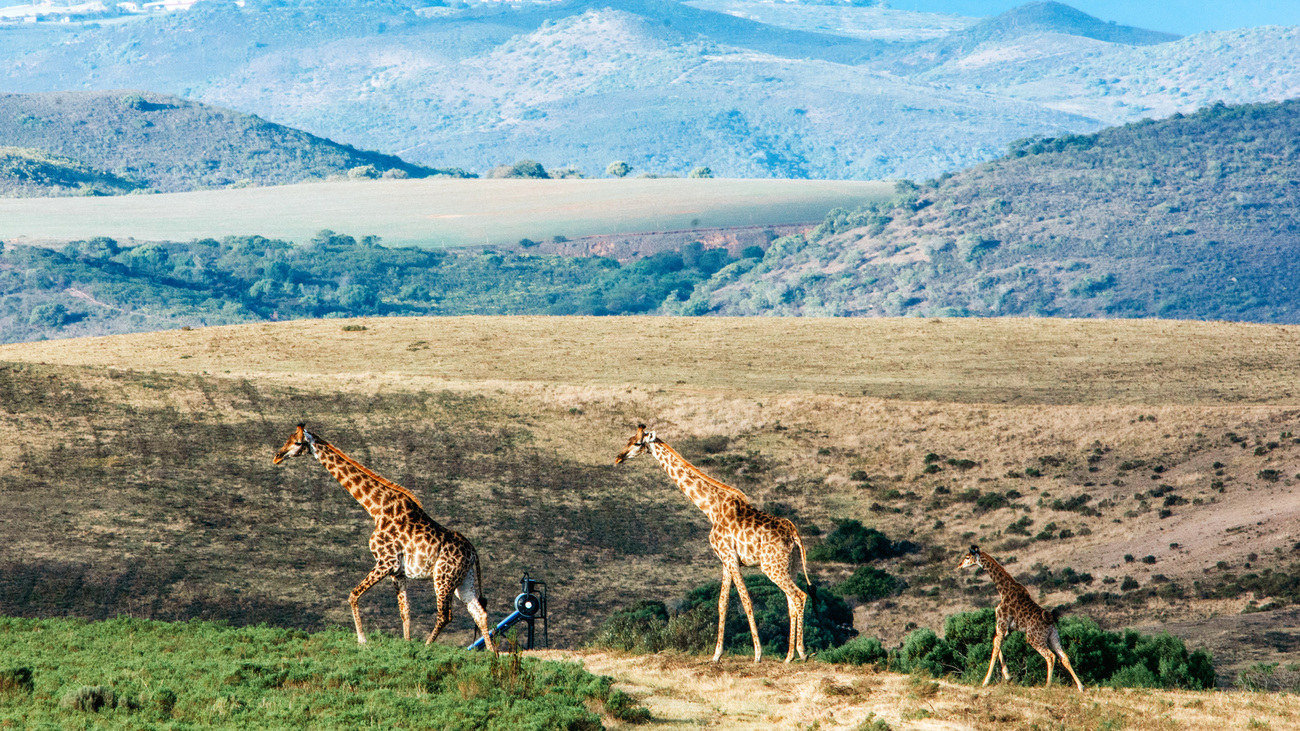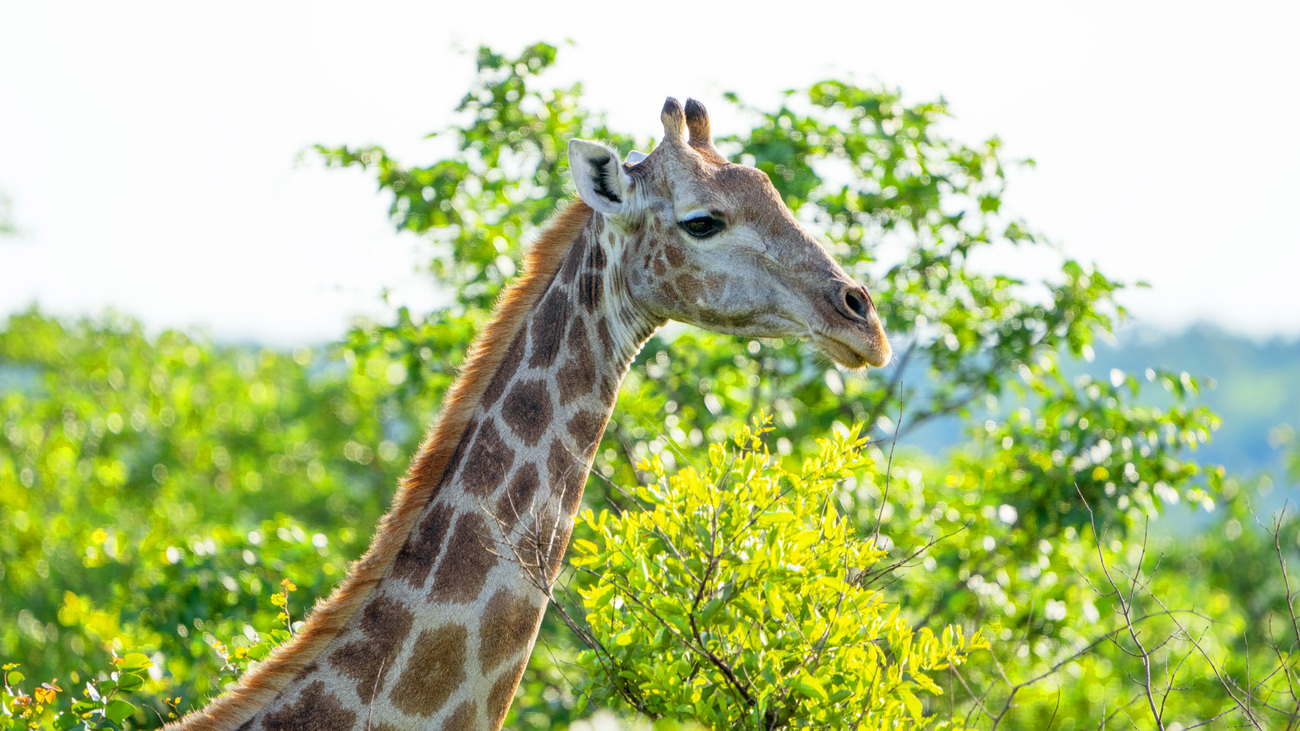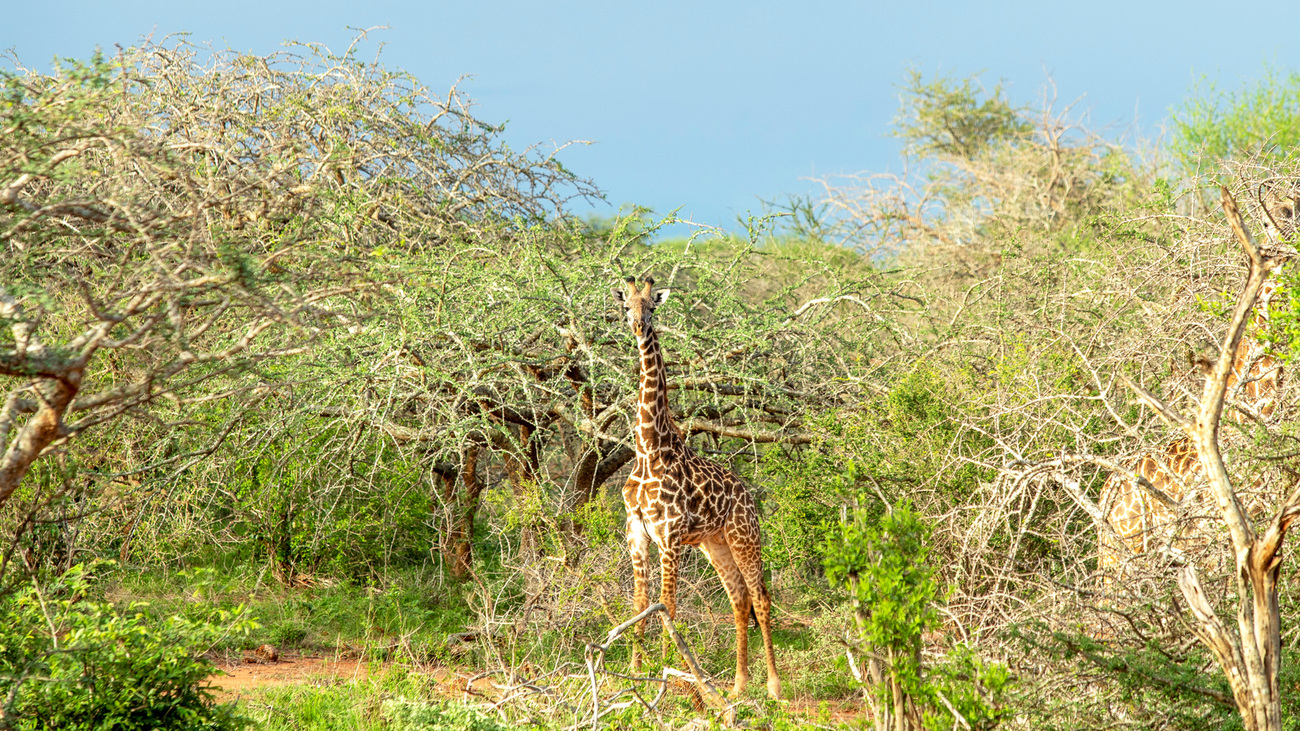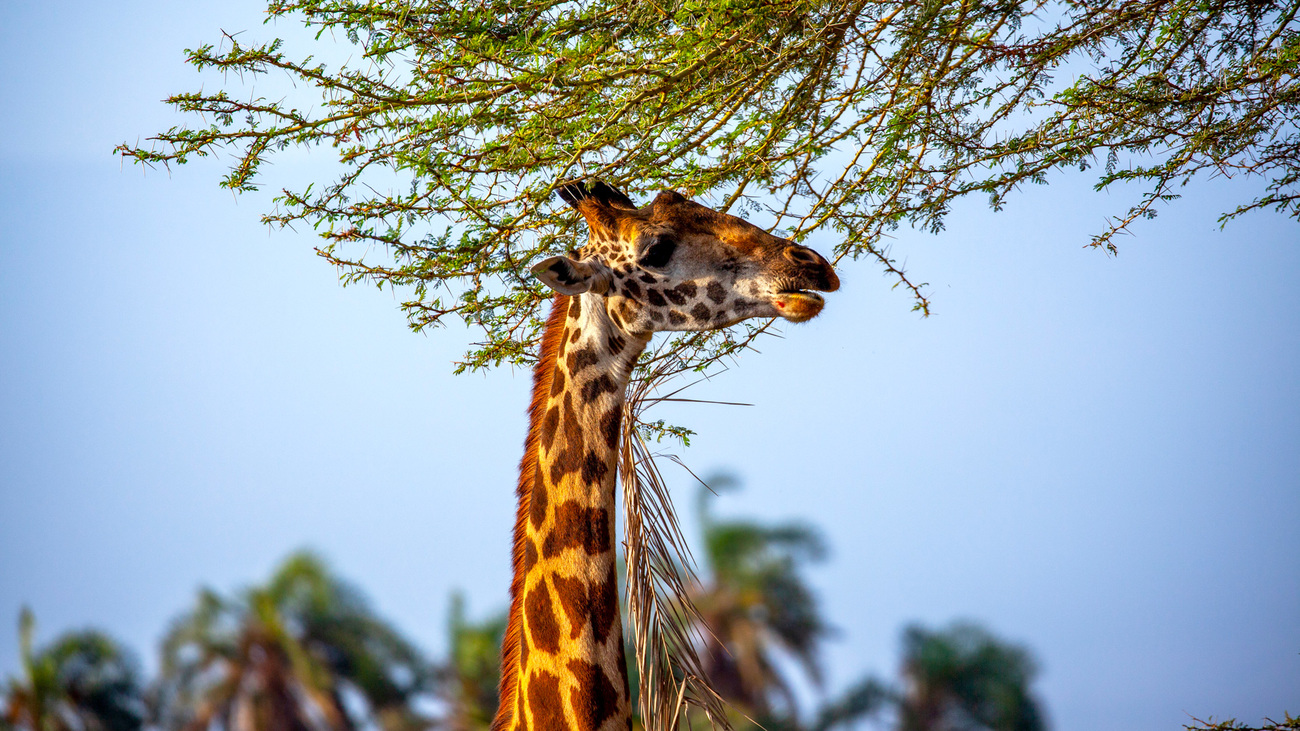Giraffes
What is a giraffe?
Giraffes are the world’s tallest land animals, standing up to 5.5 meters (18 feet) tall. They’re easily identified by their long necks (which can extend up to two meters) and their yellow and brown spotted coats. They live in a range of habitats across Africa from savannahs to woodlands, and they are highly social animals that form loose, dynamic groups known as ‘towers’. Each herd is led by a dominant male and contains a group of females and their young.
Giraffes play a crucial role in their ecosystems. As herbivores, they graze on leaves and twigs from acacia and other trees. These feeding habits contribute to the natural pruning of vegetation, influencing plant growth and maintaining a healthy balance in the ecosystems. Giraffes also help with seed dispersal, contributing to the regeneration of plant species.
Sadly, though, giraffes face a number of threats, including habitat loss, poaching, and ecological changes, which impact both their populations and the ecosystems they inhabit. Conservation efforts not only protect these animals but also contribute to the preservation of biodiversity and the ecological balance of African landscapes.
What is a giraffe’s scientific name?
The scientific name for a giraffe is Giraffa camelopardalis. The name camelopardalis is derived from camel (Greek kamēlos) and leopard (Greek pardalis), a nod to its early nickname ‘camel-leopard’—which the giraffe received for its long neck, like a camel’s, and spotted coat, like a leopard’s.
Historically, giraffes have been classed as one species with nine subspecies. However, some researchers recognize these subspecies as individual species. Here are the nine traditionally recognized giraffe subspecies:
- Kordofan giraffe (Giraffa camelopardalis antiquorum)
- Nubian giraffe (Giraffa camelopardalis camelopardalis)
- Rothschild’s giraffe (Giraffa camelopardalis rothschildi)
- West African giraffe (Giraffa camelopardalis peralta)
- Reticulated giraffe (Giraffa camelopardalis reticulata)
- Angolan giraffe (Giraffa camelopardalis angolensis)
- South African giraffe (Giraffa camelopardalis giraffa)
- Masai giraffe (Giraffa camelopardalis tippelskirchi)
- Thornicroft’s giraffe (Giraffa camelopardalis thornicrofti)
Are giraffes endangered?
Giraffes have been classed as vulnerable with a decreasing population by the
IUCN since 2016. Before 2016, they were classed as ‘least concern’, which means they have become more endangered in the past decade.
Giraffe populations across Africa face a number of threats, from habitat loss and ecological changes to illegal poaching and civil unrest.
Where do giraffes live?
Giraffes are native to the African continent and live predominantly in savannahs, where vast expanses of grasslands and scattered trees provide the perfect mix of cover and open spaces for grazing.
Most giraffe populations can be found in East Africa, particularly in reserves such as Serengeti National Park and Amboseli National Park. Some are also found in the reserves of southern Africa.
The home range of a giraffe is quite small in wet areas, roughly 85 square kilometers (33 square miles), but can extend up to 1,500 square kilometers (580 square miles) in dry regions.
Threats
Giraffe populations face several threats from humans, both directly and indirectly, which collectively contribute to a decline in giraffe numbers across their native range in Africa. These include poaching and civil unrest, along with habitat loss and ecological changes.

Habitat loss and fragmentation
The expansion of agriculture, human settlements, and infrastructure development has led to significant habitat loss for giraffes. As natural landscapes are converted for human use, the space available for giraffes to roam and find food diminishes, making it harder for them to survive.
These new settlements have also fragmented giraffes’ habitat and isolated populations. In the late 19th and 20th centuries, the average giraffe herd contained 20 to 30 individuals. Now, the average caps out at six. This affects everything from making groups more vulnerable to predators to making it harder for giraffes to find non-related mates.
Poaching
Poaching for bushmeat, traditional medicine, and the international trade in giraffe products has also contributed to population declines. Giraffes are often killed for their body parts, and without effective anti-poaching measures, these activities can have severe consequences for their survival.
In some countries, including Namibia and South Africa, hunting giraffes is legal, but giraffe population sizes there are increasing, as hunting is regulated. A 2023 study found that the greatest risk of population declines and extinction for giraffes comes from a reduction in wildlife law enforcement, leading to more poaching. It showed that an increase in law enforcement around illegal hunting would mitigate the other threats faced by giraffes, including unpredictable weather and human expansion.
Civil unrest
Armed conflicts and civil instability in certain African countries have historically led to a breakdown in conservation infrastructure, making it difficult to enforce wildlife protection measures. Giraffes became more vulnerable to threats like poaching and displacement during these periods. Between 1985 and 2015, for example, giraffe populations plummeted by 36% to 40% in countries that were experiencing ongoing civil unrest.
Ecological changes
Ecological changes can stem from many sources, including mining activity, habitat conversion for agriculture, climate-induced processes, and more.
Changes in the ecological balance of a giraffe’s habitat can impact the availability and quality of food. As herbivores, giraffes rely on specific vegetation for sustenance. Climate change-induced shifts in vegetation patterns, prolonged droughts, and altered water availability can result in food scarcity, affecting both giraffes and their habitats.
Natural habitat changes from weather irregularities can cause the need for human settlements to relocate—sometimes into protected areas where these giraffes live, in turn reducing the size of the animals’ habitat.
Drought conditions have become more common in recent years and increase the likelihood of bushfires, which will lead to a loss of habitat and more shifts in human settlements.
FAQs
What noise does a giraffe make?
Giraffes make several surprising noises that, if you heard while on a safari, you probably wouldn’t guess came from these long-necked animals. They are known to snort or hiss when threatened, and female giraffes bellow at their young. Giraffe calves may emit bleating or mewing sounds to communicate with their mothers and express needs, such as hunger or discomfort. At night, when visibility is reduced, giraffes make low-frequency humming noises that are often beyond the range of human hearing. This noise acts as a contact call to signal their location to others who may have been separated from the herd.
How do giraffes sleep?
Despite their very tall frame, giraffes usually sleep standing up so they can be ready to escape a predator at a moment’s notice. However, it’s not a deep or long sleep. They typically doze for very short bursts of 5 to 30 minutes, and they only get a total of 4 hours of sleep over 24 hours.
They are known to sometimes sit down to sleep, and they can bend their necks around to rest their heads on their rumps while in REM sleep.
What color is a giraffe's tongue?
A giraffe’s tongue is typically bluish-purple and 50 centimeters long. Its dark color comes from melanin pigmentation, which helps shield the tongue from harmful UV rays, preventing sunburn as they extend their tongues to eat.
How tall is a giraffe?
Male giraffes can be as tall as 5.5 meters (18 feet), while females may reach about 4.5 meters (14 feet) tall. Giraffes reach nearly their full height by age 4.

What do giraffes eat?
Giraffes are herbivores, so they eat shoots and leaves—mainly from acacia trees. Though the twigs and branches of these trees are often sharp and thorny, giraffes’ long tongues and the insides of their mouths have tough, protective tissue.
These animals have large appetites and can often consume around 45 kilograms (100 pounds) of leaves and twigs every single day.
How long do giraffes live?
In the wild, giraffes have been known to live to around 26 years old. The life expectancy of giraffes in captivity is slightly longer, though their quality of life is less.
What is a group of giraffes called?
Giraffes are very social animals and often hang out in groups, both for protection and because they enjoy it. Though colloquially groups of giraffes are referred to as herds, the correct name for a collective of giraffes is a ‘tower’. A group of giraffes typically includes 20 to 30 members (though the average number is decreasing), led by a dominant adult male with females and young giraffe followers.
Why do giraffes have long necks?
The defining feature of a giraffe is its neck, which can grow up to two meters (6.5 feet) long. These long necks evolved over time and provide a few advantages:
- A giraffe’s height gives it exclusive access to the topmost leaves of trees, which are out of reach to other animals with whom they may otherwise compete for food.
- Of course, being tall also helps them look out for predators. Giraffes have excellent eyesight, and the elevated position allows them to detect potential threats like lions or hyenas early, providing more time for the group to react and escape.
- Male giraffes use their long necks as weapons against other giraffes in fights—in a behaviour called ‘necking’, they swing their necks at each other. This behavior is often a display of dominance during mating competitions or territorial disputes.

Can giraffes swim?
Giraffes cannot swim as their heavy bodies, lanky limbs, and long necks are quite cumbersome in the water. However, their height allows them to wade through deep water when they need to cross a waterway. They are also quite buoyant and can float for short periods.
How long is a giraffe pregnant for?
A giraffe’s gestation period—the time between conception and giving birth—lasts around 15 months. Typically, a female giraffe gives birth to a single calf, although twin births can occur on rare occasions. Most calves are born in dry months, though births do occur in every month of the year. A newborn giraffe stands two meters (6.5 meters) tall and weighs 100 kilograms (220 pounds).
Female giraffes give birth standing up. The calf is born head first, dropping nearly 1.5 meters (5 feet) to the ground. The entire birthing process is relatively quick and, within an hour, the calf can stand and start nursing from its mother.
How many giraffes are left in the world?
Giraffes are estimated to have about 117,000 individuals remaining. Their numbers are reportedly declining.
Our work
IFAW has engaged in and supported conservation efforts in Africa to help protect giraffes and prevent their population from declining even further. Some of our efforts include rescuing a giraffe from a poacher’s spear and working with our Olgulului Community Wildlife Rangers to reunite an abandoned week-old giraffe with its mother.
Our rangers on the ground are constantly on the lookout for injured or vulnerable giraffes. In 2023, IFAW-supported community wildlife rangers discovered 12 Masai giraffes lying helpless in the sweltering heat, prevented from reaching water sources because of fences erected by private farmers. The rangers were able to negotiate with stakeholders to get water trucks to the giraffes to quench their thirst, and now, with the help of IFAW, they are fighting to have these fences removed.
We’ve also contributed to policy changes benefitting giraffes. Thanks to our work and the help of others, in 2019 giraffes were given international protection from trade for the first time, under CITES.
However, at the 2025 meeting of CITES, some southern African are seeking to remove CITES protections for their giraffe populations. IFAW continues to advocate for giraffes’ safety and keep them protected from trade.

Video
How can you help?
Help us continue our life-saving work for giraffes and other vulnerable animals around the world.
